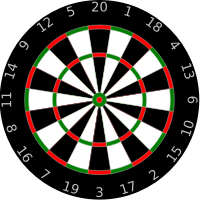
 |
Exam-Style Questions.Problems adapted from questions set for previous Mathematics exams. |
1. | GCSE Higher |
A circular dart board has radius of 30 cm.
(a) Calculate the area of the front face of the dart board in cm2, giving your answer as a multiple of \(\pi\).

(b) The volume of the dart board is 4500\(\pi\) cm3. Calculate the thickness of the dart board.
2. | GCSE Higher |
(a) Simplify.
$$\sqrt{48} + \sqrt{72}$$
(b) Rationalise the denominator.
$$\frac{1}{\sqrt{5} - 3}$$
3. | GCSE Higher |
(a) Express \( \sqrt{5} + \sqrt{20} \) in the form \( a \sqrt{5} \) where \(a\) is an integer.
(a) Express \( ( \frac{1}{ \sqrt{5} } ) ^ 9 \) in the form \( \frac{ \sqrt{b}}{c} \) where \(b\) and \(c\) are integers.
4. | GCSE Higher |
(a) Write this list of numbers in order, smallest first.
$$\sqrt{47}, \frac{22}{3}, 3.5^2, 8.65$$(b) Write \((1 + \sqrt5)^2\) in the form \(a + b\sqrt5\) .
5. | A-Level |
The cosine of acute angle \( \alpha \) is \( \frac{1}{ \sqrt 5} \)
The angle \( \beta \) is obtuse and \( \sin \beta = \sqrt \frac{2}{3} \).
(a) Find exact values of \( \tan \alpha \) and \( \tan \beta \).
(b) Hence show that \( \tan( \alpha - \beta ) \) can be written as \(a+b \sqrt 2 \) where \(a\) and \(b\) are rational numbersIf you would like space on the right of the question to write out the solution try this Thinning Feature. It will collapse the text into the left half of your screen but large diagrams will remain unchanged.
The exam-style questions appearing on this site are based on those set in previous examinations (or sample assessment papers for future examinations) by the major examination boards. The wording, diagrams and figures used in these questions have been changed from the originals so that students can have fresh, relevant problem solving practice even if they have previously worked through the related exam paper.
The solutions to the questions on this website are only available to those who have a Transum Subscription.
Exam-Style Questions Main Page
To search the entire Transum website use the search box in the grey area below.
Do you have any comments about these exam-style questions? It is always useful to receive feedback and helps make this free resource even more useful for those learning Mathematics anywhere in the world. Click here to enter your comments.